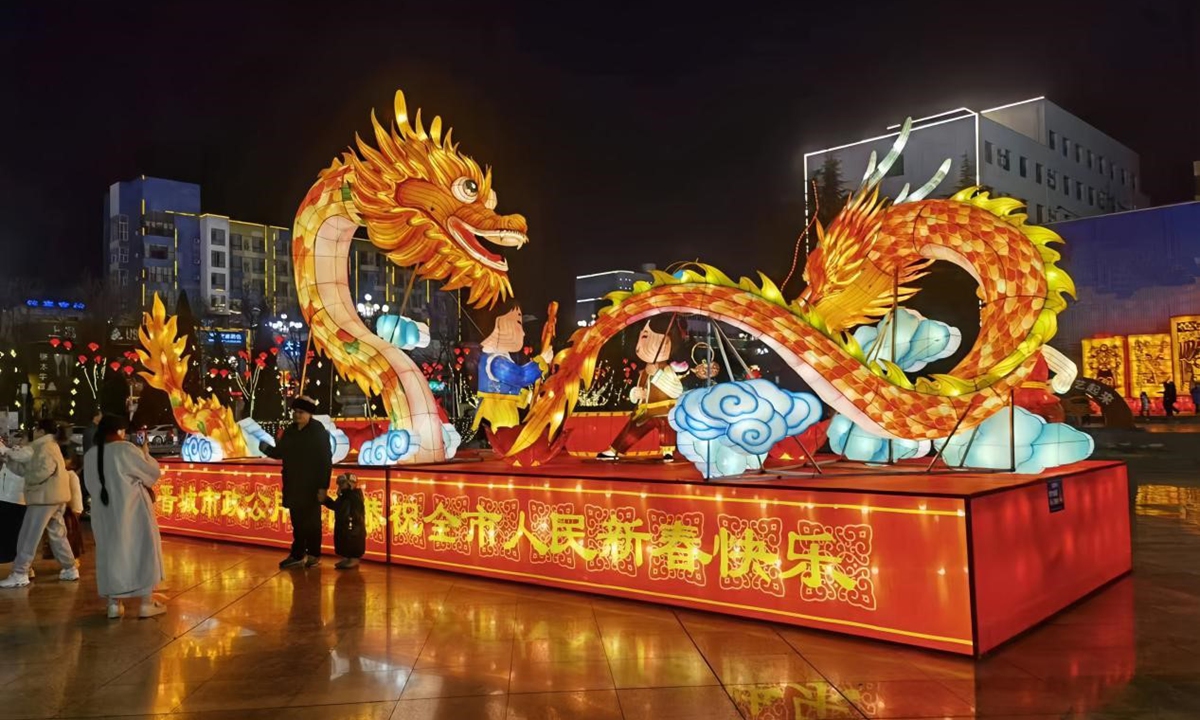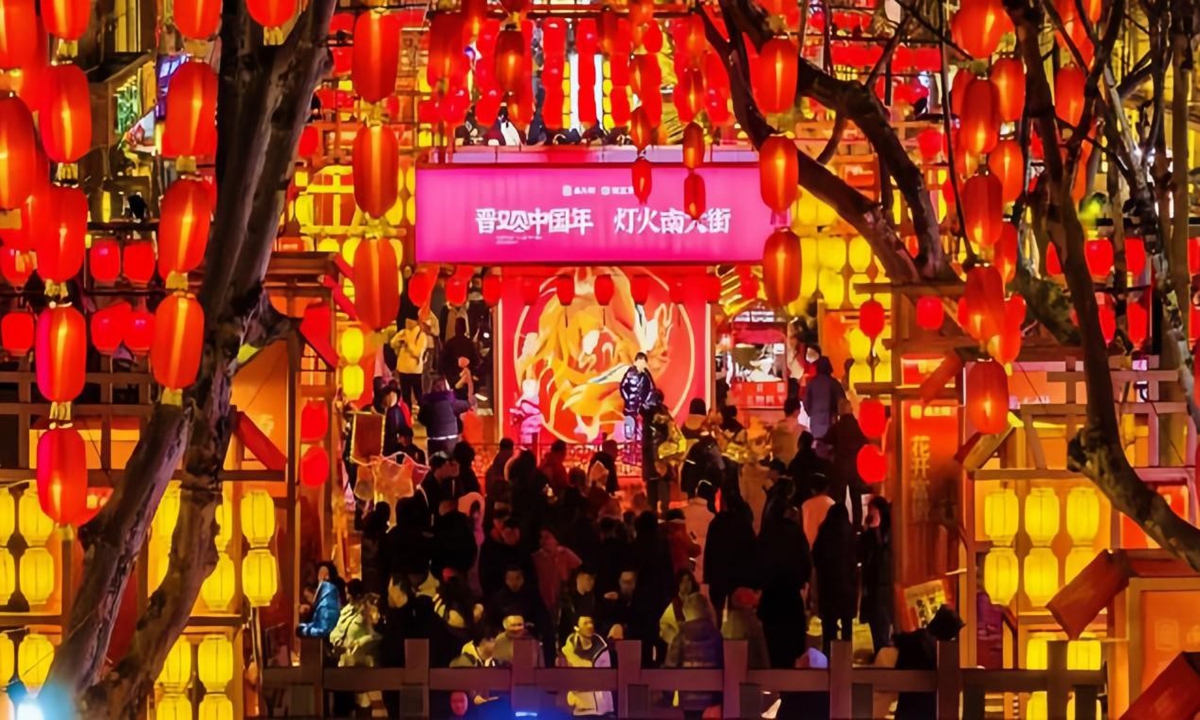
Photo: Wang Zixuan
Under dazzling street lanterns, the Spring Festival lantern fairs demonstrate the flourishing cultural economy and rich heritage in Shanxi Province of northern China. Among them, a lantern fair with local characteristics was presented on the most bustling street of Jincheng, Shanxi.
Integrating traditional culture and modern technology, Jincheng City launched a series of cultural immersion programs online and offline during the fair, which not only adds to the festive atmosphere, but also shows the vitality of Chinese economy.
Charming traditional culture with innovative formsFeatured by a 600-meter lantern alley and immersive cultural performances, the event presents the most typical elements of Chinese Spring Festival, such as New Year paintings and cultural goods, and creatively combines them with local customs of Shanxi Province, which highlight traditional culture through New Year paintings exhibition, fireworks parade, lantern game, New Year goods bazaar, etc. These activities deeply reflect traditional Chinese New Year's culture, and dig into local New Year's customs and local culture, bringing a marvelous experience of Spring Festival that integrates lanterns, bazaars, performances, cuisine, entertainment and other cultural experiences for locals and tourists. As a tourist from Hebei Province said, "the festival lanterns shine on people's happy faces, also shine the night of the beautiful city."
The biggest highlight of this lantern fair is the 180-minute live performance on the South Street. With a blend of music, dances and artistic performances, it leads the audience to "touch" the history, culture and folklore of this ancient city through an immersive tour. Beside the stage, people lined up in front of the stalls, trying to making lanterns by themselves or picking up diverse goods and specialties, so that tourists can personally explore the charm of traditional culture.
Moreover, many intangible cultural heritages were presented in the form of lanterns, showcasing the profound cultural deposits in this ancient city in northern China. These lanterns, including the shapes of flower-shaped bun, lion dance and dragon dance, etc., vividly demonstrate how the local people celebrate the Spring Festival, and allow local people and tourists to learn about the city's intangible cultural heritage. Among them, the idea of flower-shaped bun lantern is taken from Shanxi's traditional custom of making steamed flower-shaped buns for celebration, implying harvest and blessings for this year. At the same time, lantern is an important part of Chinese New Year culture, colorful lanterns with different shapes have become one of the symbols of traditional customs, as well as a carrier of people's higher pursuit and aspirations of the new year.
Through these cultural displays and products, the old generation saw the innovation of intangible cultural heritage, and the young generation learned the connotation of Chinese traditional culture. In this way, it better passed down the valuable heritage, and more importantly, yielded enormous economic benefits. Hence, the charm of traditional culture is constantly enriching the connotation of high-quality development, and better satisfying the growing demands of the people for a better life.

Photo: Wang Zixuan
New aspirations
In recent years, Jincheng has continuously upgraded and innovated the street construction based on the traditional culture with local characteristics, and developed a modern commercial street while retaining traditional architecture to the greatest extent, realizing the perfect integration of history and modernity, culture and commerce, and injecting vitality into local economy.
The cultural industry is connected to economic and social development on one end, and the people's ardent hope for a better life on the other. Take the Spring Festival celebration in Jincheng, Shanxi, as an example, the bustling cultural economy is precisely a vivid manifestation of the vitality of the local economy. All of these festival events showcase the abundant heritage of Chinese culture, the fruits of economic development and the happiness of the general public.
According to Culture and Tourism Department of Shanxi Province, the first two days of the Spring Festival holiday witnessed 1,173,800 tourists inits 66 key scenic spots, an increase of 151.61 percent; the cumulative ticket revenue reached RMB 27,859,600 yuan, an increase of 123.46 percent.
Behind the fast-growing cultural economy of the Spring Festival is the new vitality of consumption based on the combination of traditional cultural elements and modern trends. The new cultural and tourism industry formats, new cultural scenarios and innovative products that highlight the characteristics of traditional Chinese culture, not only carry on the tradition of the Spring Festival, but also achieve a harmonious symbiosis of the Spring Festival culture and the modern economy. In other words, the local economy can be greatly stimulated by activities and products deriving from Spring Festival culture.
Meanwhile, the burgeoning cultural economy is a vivid embodiment of China's advantage of the mega-market, and also a powerful illustration of China's economy with steady progress. The continuous innovation of the cultural industry, increasingly diversified consumption scenarios, and strong support in market supply have jointly contributed to the surging economy during the Spring Festival holiday.
The Spring Festival fair in Shanxi is only one of the numerous cases of a thriving Chinese economy, in which people witnessed the symbiotic development of culture and economy, and the Chinese practice of high-quality development. The growing number in statistics clearly show the consumption upsurge during the Spring Festival, the demands of consumers for innovative New Year's traditions, as well as their confidence and expectations in the new year.





